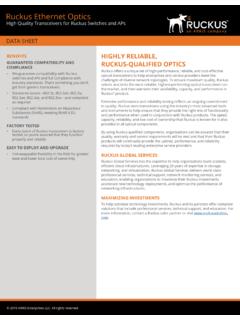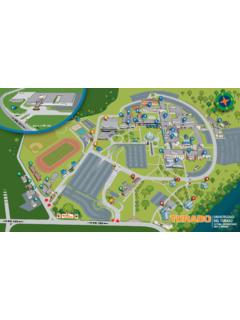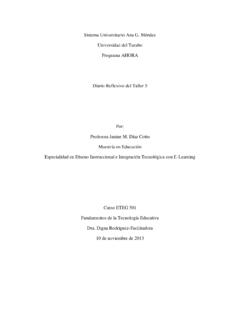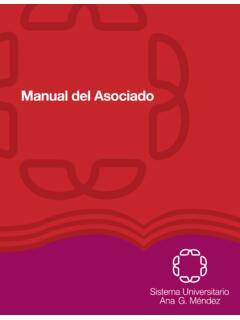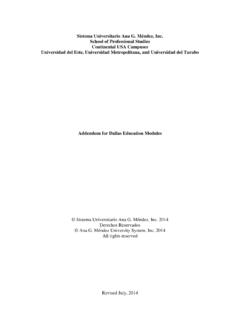Transcription of C A S E S T U D Y Higher Education
1 Delivering reliable wireless everywhere for more than 40,000 students and staff, one of the largest university systems in Puerto Rico, Sistema University Ana G. Mend z (SUAGM, by its Spanish acronym) needed a new IT budget was getting squeezed, SUAGM s eight IT staff was already overwhelmed, students were bringing in more multimedia-capable wireless devices and the existing wireless network, consisting of more than 200 Enterasys and HP ProCurve access points (APs) and controllers, was buckling under the load of increasing video and data goal to install a Higher speed wireless LAN (WLAN) across its university system was daunting. SUAGM operates three massive campuses: Universidad Metropolitana, Universidad del Turabo and Universidad del Este. These campuses consume hundreds of acres throughout Puerto Rico and house more than 50 multi-story buildings.
2 Due to intermittent failures, inconsistent performance and dropped connections, SUAGM has dedicated full-time IT resources to the operation and optimization of their WLAN. Outdoor coverage was limited and was achieved by installing antennas outside of building and running coaxial cable to indoor APs already in place. The instability of our legacy wireless LAN impeded our ability not only to provide user access but also to introduce new applications on the network that could improve operations and the educational experience, said Oscar Hern ndez, chief information officer at SUAGM. Built to provide casual wireless access, the legacy Wi-Fi network was failing to deliver consistent performance and reliable connectivity to students and staff spread across its three campuses and 15 off-campus to 75% of students were now attending classes with wireless laptops with 80-90% of students armed with Wi-Fi-enabled PDAs or requirement for wireless coverage everywhere were underscored by the need to provide more reliable wireless connections, both indoors and outdoors, using a full-featured wireless system that could be easily and quickly deployed and centrally-managed from any location.
3 COMPANY OVERVIEWF ounded in the early 1940s by Ana Gonz les de M ndez, Alfredo Mu iz Souffront and Florencia Pag n Cruz, Sistema University Ana G. M ndez (SUAGM) is one of the largest university systems in Puerto Rico. With three main campuses and 15 off campus centers, SUAGM provides Higher Education to more than 42,000 Ubiquitous indoor and outdoor and 5 Ghz Wi-Fi coverage Wireless mesh support High capacity, high performance Wi-Fi with dual-band Support for a wide range of Wi-Fi security such as WPA2, , and captive portal guest access Easy and quick installation Bandsteering and airtime fairness to optimize Wi-Fi spectrum RF interference avoidance and mitigation Central management of WLAN with no in-line datapath requirements for controller Higher client density per AP SOLUTION 125 Ruckus ZoneFlex 7962 indoor dual-band APs Ruckus ZoneFlex 7762 dual-band outdoor APs.
4 Ruckus ZoneDirector 3100 wireless LAN controllers BENEFITS Complete indoor-outdoor coverage with 40% fewer APs Higher and more consistent performance at range Half the cost of competing systems Better reliability through dynamic beamformingHigher EducationCASE STUDYM ulti-Campus University System Makes Big Move to Smarter Wi-Fi to Cope with Wireless ExplosionSUAGM standardized on Ruckus ZoneFlex dual-band indoor and outdoor APs throughout three massive campuses and 15 off campus centers with 40% fewer APs delivering Higher Wi-Fi performance, better range and consistent reliability over its legacy wireless LAN universitario Ana G. M ndez In our evaluation tests we found a remarkable difference between wireless LAN systems. The Ruckus ZoneFlex system consistently delivered a 5:1 performance advantage and three times the coverage at half the cost of others.
5 This was simple impossible to ignore. Oscar Hern ndezChief Information Officer sistema universitario ana g . M ndez Higher EducationCASE STUDYRIGHT: Smart Wi-Fi architecture for SUAGM s Universidad Metropolitana campusSupport for IP-based streaming video, wireless meshing, wireless backhaul, bandsteering, airtime fairness and robust security options that could be implemented for different user groups were all top requirements. SUAGM also wanted to migrate to Higher -speed dual band This would allow them to support more media-rich applications and a Higher density of users per AP. We saw this set of requirements actually working against us, said Hern ndez. Most of the wireless LAN systems that could support our needs were well beyond our reach with respect to cost and complexity. This posed a very real challenge to us: How could we migrate such a large network to simply and cost-effectively?
6 Test, Test, TestSo the IT staff at SUAGM began testing and evaluating wireless solutions from a variety of competing vendors including: Aruba, Cisco, Meru Networks, Nortel and Ruckus Wireless. The first course of action was to validate performance, latency, range, reliability and ease of use. Side-by-side testing included streaming tests and a simple 100MB file download to a dozen different types of laptops at different locations. In these tests, the download time of the 100MB file for the Ruckus ZoneFlex system was under three seconds, compared to 10 to 15 seconds with the nearest competitive WLAN system. In our evaluation tests we found a remarkable difference between wireless LAN systems. The Ruckus ZoneFlex system consistently delivered a 5:1 performance advantage and three times the coverage at half the cost of others.
7 This was simple impossible to ignore, said Hern AIRSUAGM also tested how each WLAN system performed in providing fair access and effective spectrum utilization given a diversity of different speed client devices. With various clients on the network, the Ruckus ZoneFlex system was able to differentiate between clients and newer stations and assigned the right amount of spectrum time to each so slower clients wouldn t penalize Higher -speed laptops, said Miguel Paulino, manager of Networks and Telecommunications at SUAGM. Some systems we evaluated could do this but others couldn t while none of them were able to combine airtime fairness and bandsteering capabilities with dynamic beamforming at the RF layer. This combination has proven invaluable for supporting high-density areas such as auditoriums, large classrooms and areas where hundreds of users are concurrently accessing the wireless network.
8 All Ruckus ZoneFlex Smart APs provide default support for airtime fairness and bandsteering. With airtime fairness enabled, transmit queues are scheduled based on the airtime constraints per station using weighted round robin algorithm. With airtime fairness, users have an equal time on the air and can continue to send packets so long as their airtime use allows. This lets clients with faster potential throughput recapture the advantages of their Higher rate potential and increases overall network 2010, Ruckus Wireless, Inc. All rights reserved. Ruckus Wireless and Ruckus Wireless design are registered in the Patent and Trademark Office. Ruckus Wireless, the Ruckus Wireless logo, BeamFlex, ZoneFlex, MediaFlex, MetroFlex, FlexMaster, ZoneDirector, SpeedFlex, SmartCast, and Dynamic PSK are trademarks of Ruckus Wireless, Inc.
9 In the United States and other countries. All other trademarks mentioned in this document or Website are the property of their respective owners. 802-70983-001 rev 02 Some systems we evaluated could support fair spectrum allocation but others couldn t. And none of them were able to combine airtime fairness and bandsteering capabilities with dynamic beamforming at the RF layer. Only ZoneFlex was able to provide such functionality. Miguel Paulino Manager Networks and Telecoms sistema universitario ana g . M ndezHigher EducationCASE STUDYRIGHT: From a ZoneDirector, SUAGM is able to view all indoor and outdoor AP as well as associated client connections, blacklist clients, run client speed tests and perform a variety of management functions through an ultra-simple point-and-click graphical user also allows more efficient utilization of the RF spectrum by directing dual-band capable clients to 5 GHz by withholding probe and authentication responses on A client table within each AP tracks client probe requests and average RSSI per band every minute.
10 This table is checked before responding to client. Also clients are not steered below RSSI threshold for a given WLAN. Deployment DetailsSUAGM is replacing hundreds of indoor access points with new ZoneFlex 7962, dual-band access points across its three main university campuses. ZoneFlex 7762s provide dual-band Wi-Fi coverage to outside areas around each campus. ZoneDirector 3100s have been deployed to provide central management and control the entire WLAN infrastructure across all three deployment, SUAGM saw that it could achieve full coverage of each campus with 40 percent fewer access points than its previous system. This shocked us, said Paulino. Not only did we have full coverage but the performance and reliability of connections improved dramatically - allowing us to begin looking at deploying new multimedia applications over Wi-Fi such as IP-based voice, streaming video and video conferencing.

